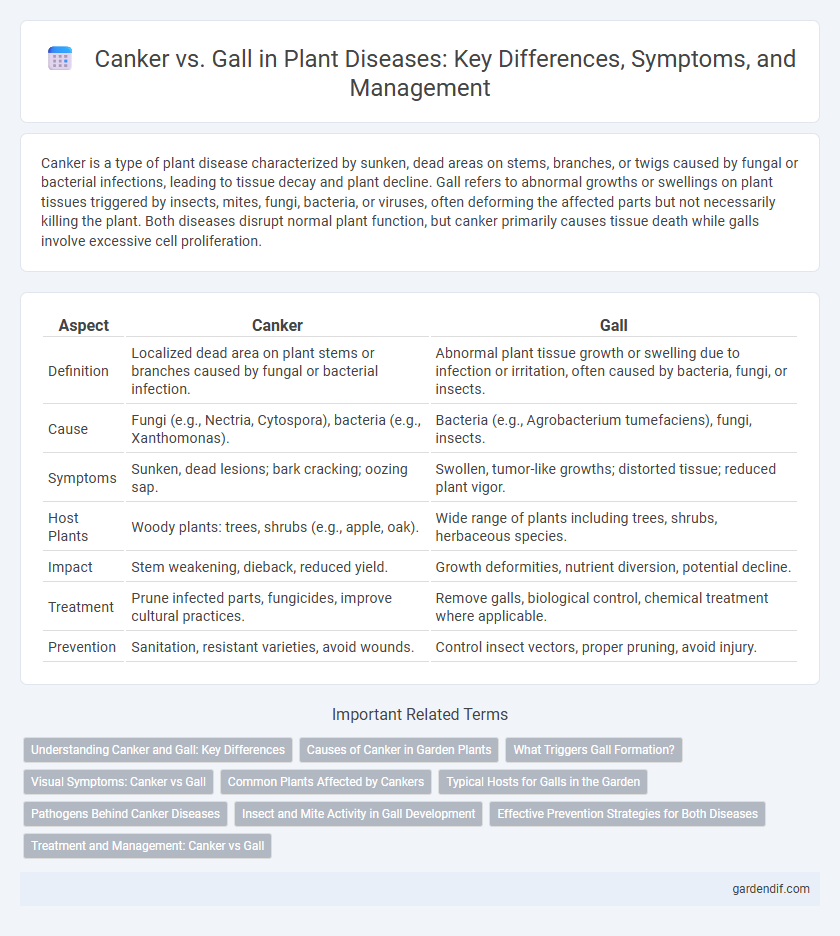
Canker vs Gall Illustration
Canker is a type of plant disease characterized by sunken, dead areas on stems, branches, or twigs caused by fungal or bacterial infections, leading to tissue decay and plant decline. Gall refers to abnormal growths or swellings on plant tissues triggered by insects, mites, fungi, bacteria, or viruses, often deforming the affected parts but not necessarily killing the plant. Both diseases disrupt normal plant function, but canker primarily causes tissue death while galls involve excessive cell proliferation.
Table of Comparison
| Aspect | Canker | Gall |
|---|---|---|
| Definition | Localized dead area on plant stems or branches caused by fungal or bacterial infection. | Abnormal plant tissue growth or swelling due to infection or irritation, often caused by bacteria, fungi, or insects. |
| Cause | Fungi (e.g., Nectria, Cytospora), bacteria (e.g., Xanthomonas). | Bacteria (e.g., Agrobacterium tumefaciens), fungi, insects. |
| Symptoms | Sunken, dead lesions; bark cracking; oozing sap. | Swollen, tumor-like growths; distorted tissue; reduced plant vigor. |
| Host Plants | Woody plants: trees, shrubs (e.g., apple, oak). | Wide range of plants including trees, shrubs, herbaceous species. |
| Impact | Stem weakening, dieback, reduced yield. | Growth deformities, nutrient diversion, potential decline. |
| Treatment | Prune infected parts, fungicides, improve cultural practices. | Remove galls, biological control, chemical treatment where applicable. |
| Prevention | Sanitation, resistant varieties, avoid wounds. | Control insect vectors, proper pruning, avoid injury. |
Understanding Canker and Gall: Key Differences
Canker and gall are plant diseases characterized by abnormal growths, but canker typically presents as sunken, dead areas on stems or branches caused by fungal or bacterial infections, while galls are swollen, tumor-like growths induced by insects, mites, fungi, or bacteria. Canker lesions often disrupt nutrient flow, leading to dieback, whereas galls generally cause localized swelling without systemic harm. Accurate identification of canker versus gall is crucial for effective disease management and preventing crop loss in agriculture and horticulture.
Causes of Canker in Garden Plants
Canker in garden plants is primarily caused by fungal pathogens such as Botryosphaeria, Nectria, and Phytophthora species, which invade through wounds or natural openings on stems and branches. Environmental stressors like drought, frost injury, and poor soil drainage exacerbate the development of canker by weakening plant defenses. Insects and pruning injuries also create entry points, facilitating infection and the spread of canker lesions.
What Triggers Gall Formation?
Gall formation is primarily triggered by the presence of insects, mites, fungi, bacteria, or nematodes, which induce abnormal plant tissue growth as a response to their feeding or invasion. Hormonal imbalances caused by these organisms manipulate plant cell division and differentiation, leading to the characteristic swellings or tumor-like structures. Environmental stress factors do not directly cause galls but can exacerbate their development by weakening plant defenses.
Visual Symptoms: Canker vs Gall
Canker typically appears as sunken, discolored lesions on stems or branches, often accompanied by cracked or dead bark, indicating tissue decay. Galls manifest as abnormal, rounded swellings or growths on leaves, stems, or roots, caused by insect, mite, or pathogen activity distorting normal plant tissue. Visual differentiation hinges on the presence of sunken necrotic areas in cankers versus raised, tumor-like protrusions characteristic of galls.
Common Plants Affected by Cankers
Cankers commonly affect woody plants such as apple trees, oaks, and poplars, causing sunken, dead areas on branches and trunks. These fungal or bacterial infections disrupt nutrient flow, leading to dieback and reduced plant vigor. In contrast, galls typically form on a wider range of plants due to insect or mite activity, rather than primarily fungal or bacterial pathogens.
Typical Hosts for Galls in the Garden
Galls typically affect a wide range of garden plants, including oak trees, roses, and maple trees, where they develop as abnormal growths caused by insects, mites, or fungi. Unlike cankers, which primarily attack woody stems and branches leading to sunken lesions, galls are more common on leaves, buds, and twigs, often triggered by gall wasps or aphids. Understanding the specific hosts prone to galls helps gardeners implement targeted pest and disease management strategies to preserve plant health.
Pathogens Behind Canker Diseases
Canker diseases are primarily caused by fungal pathogens such as Botryosphaeria, Nectria, and Cytospora species, which infect tree bark and vascular tissues, leading to necrotic lesions and structural weakening. In contrast, galls are often induced by bacteria like Agrobacterium tumefaciens or by insects and mites, resulting in abnormal plant tissue growth rather than tissue death. Understanding the specific pathogens behind canker diseases aids in developing targeted management strategies to prevent devastating damage to crops and ornamental plants.
Insect and Mite Activity in Gall Development
Gall development primarily results from intricate interactions between insects or mites and host plant tissues, where these organisms induce abnormal cell growth by injecting chemicals or manipulating hormonal balances. In contrast, cankers are typically caused by fungal or bacterial pathogens rather than direct insect or mite activities, although these pests can contribute to stress that facilitates canker formation. Specific insects like gall wasps and mites such as eriophyid mites play critical roles in forming galls by creating localized swelling, while canker symptoms manifest as sunken lesions due to pathogen invasion and subsequent tissue necrosis.
Effective Prevention Strategies for Both Diseases
Effective prevention strategies for canker and gall diseases involve maintaining plant health through proper watering, pruning, and sanitation to reduce pathogen entry points. Using resistant plant varieties and applying targeted fungicides or bactericides at early disease stages can significantly minimize infection rates. Regular monitoring and prompt removal of infected plant parts help interrupt disease cycles and limit spread within susceptible plant populations.
Treatment and Management: Canker vs Gall
Canker treatment involves pruning infected branches to improve air circulation and applying fungicides or bactericides specific to the pathogen, while ensuring proper sanitation to prevent spread. Gall management focuses on removing and destroying affected plant parts, using insecticides if gall formation is insect-induced, and promoting plant health to enhance resistance. Regular monitoring and cultural practices such as balanced fertilization and avoiding plant stress improve overall disease control for both canker and gall.
Canker vs Gall Infographic

 gardendif.com
gardendif.com